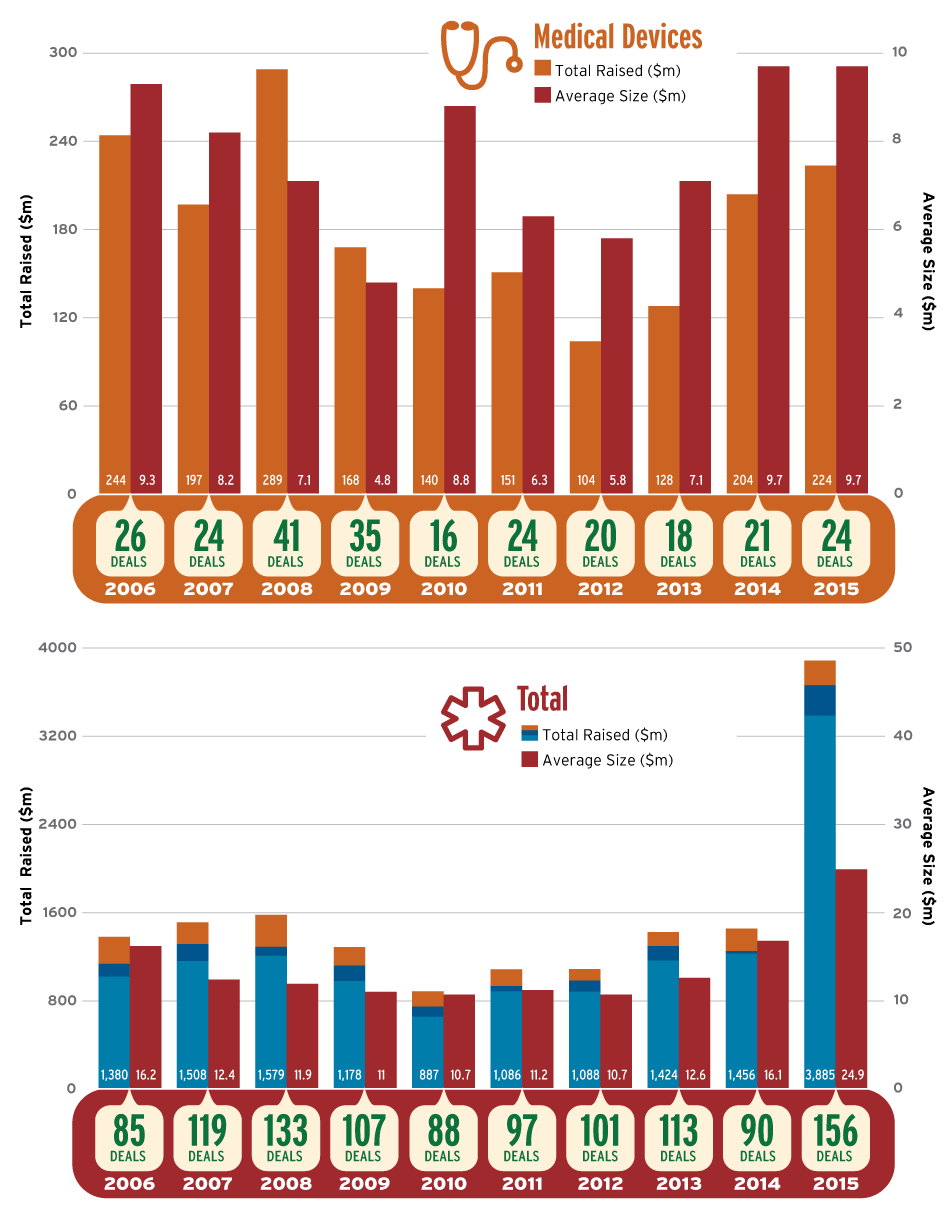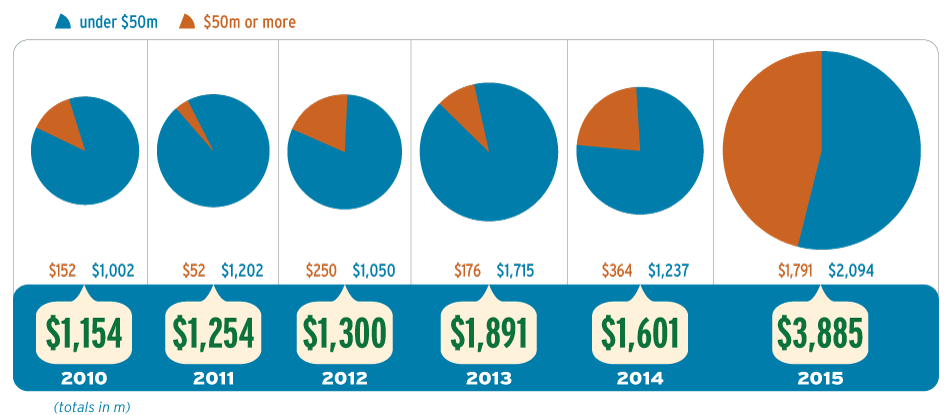Early-Stage Investments Propel Jump In Life Sciences Venture Capital
This article was originally published in The Tan Sheet & The Rose Sheet
Executive Summary
In some cases, early venture capital appears to be substituting for the public market in providing finance not only to start but also sustain companies in specialty pharma and in-licensing, development-only businesses. At least 200 capital groups took part in the 156 recorded A rounds, and 50 participated in more than one.
A drift of venture capital toward life sciences and a massive shift in the timing of those investments pushed investment in 2015 to nearly $3.9bn in biopharma, pharma, med tech and diagnostics firms' A rounds, the highest for a single year and close to double the highest previous year.
Generally, 2015 was a bonanza year for venture capital investment. More venture capital was deployed across all sectors in the US than in any year since 2000, according to the third-quarter MoneyTree Report from PricewaterhouseCoopers.
The MoneyTree analysis includes investments not only in health care companies but also in those involved in telecoms, software, financial services, retailing, media, IT, business products and other industry segments.
In 2000, biotech and med tech investments accounted for only 6.4% of the venture capital deployed for the life sciences, with much of the rest going into software, telecoms and media. But with telecoms venture capital all but disappeared in the US, software and media account for nearly half of US venture capital spending and the proportion going to the life sciences in 2015 increased, to 16.8%.
The year marked the biggest ever for life science venture capital: Informa's Strategic Transactions database, which covers investments both in the US and outside, recorded $11.5bn in venture investments, over $3bn more than the previous record in 2007 (see charts below).
Another component in the 2015 investment boom, a shift in the timing, was seen in a higher proportion of capital going to early venture rounds (both A and B) than in previous years. Since the start of the global recession, the amount of venture capital placed in C rounds or later has increased around 34% – from $3.35bn in 2008 to $4.5bn in 2015; however, over the same period, capital placed in A and B rounds has increased 112%, from $3.3bn to $7bn.
Series A round financing was especially prominent in 2015, accounting for $3.9bn or 33% of all life science investment recorded in Strategic Transactions, up 21% from the life science total in 2014.
Life Science Series A Financings Of 2015: By The Numbers


Strategic Transactions
Part of the explanation for this shift is that the public markets have largely taken care of the later-stage capital demands of life science companies, enabling venture investors to deploy their capital on new or early-stage opportunities. The public markets finance bonanza of 2013-2015 (which saw more than 320 biopharma, device and diagnostic companies collectively raise over $21bn) meant that venture capital was not deflected into late-stage enterprises, a tendency seen before the public finance window opened.
A related explanation is that the open public markets allowed venture investors to exit current investments, thereby both recycling money to existing limited partners and demonstrating the kind of profitability that will expand the base of limited partners.
As an example, by the end of March 2015, one of the most dynamic venture backers in biotech, Flagship Ventures, had pulled together its largest ever life science fund, worth $537m (twice its previous fund), following eight IPO exits over the previous two years including Seres Therapeutics Inc.($10.5m A round November 2013; $134m IPO June 2015) and Eleven Biotherapeutics Inc.($45m A round February 2010; $57.5m IPO February 2014). [See Deal][See Deal][See Deal][See Deal] Flagship subsequently invested in the 2015 A rounds of neurodegeneration play Denali Therapeutics Inc. (on our 2015 A-List) and exosome-based drug delivery firm Codiak BioSciences Inc.[See Deal][See Deal]
Beneath the shifts in investor preferences and the dynamics of interplay between the private and public capital market another change in the pattern of investor behavior is apparent: a few investors are putting large chunks of capital into life science companies at the earliest possible stage.
The combination of general enthusiasm by venture capital in 2015 plus specific enthusiasm for health care plus a diminished need for VCs to support later-stage projects all contributed to the $2.43bn, 167% surge in A round financing in 2015.
However, beneath the shifts in investor preferences and the dynamics of interplay between the private and public capital market, another change in the pattern of investor behavior is apparent: a few investors are putting large chunks of capital into life science companies at the earliest possible stage.
Historically, venture capital rounds of above $50m have been rarities: prior to 2015 only 5.8% of VC deals and only 2.5% of A rounds exceeded that threshold. But in 2015, 16.3% of all VC deals exceeded $50m.
More $50m-plus A rounds occurred in 2015 (11; 8%) than occurred in the previous five years (2010–2014) taken together. Those 11 A rounds account for nearly half (46%) of the record value of A round financing raised in 2015. (See Exhibit 2.) In the previous five years, $50m-plus rounds accounted for only 14% of A round funding.
Big Rounds Make The Difference
Series A round funding in 2015 is twice that of earlier years thanks to rounds in excess of $50 million.

Note: size of circle, total $ value of A rounds.
Strategic Decisions
It appears a new model for venture capital investment at the high end of the spectrum is emerging, one in which the A round provides all the capital companies need to become IPO-ready. (See (Also see "Biotech IPOs: High Tide" - Scrip, 14 Apr, 2015.).)
This is a pattern that emerged in 2014 when huge bets were placed on companies such as Juno Therapeutics Inc.and Adaptimmune Therapeutics PLC. These firms operate in technically complex and competitive arenas (immuno-oncology, in both cases) and the colossal A round cash influx reduced their risk by allowing them to out-develop competitors or to access competitor technology through licensing or acquisition.
Juno, for instance, only founded in December 2013, closed its $176m A round financing in April with a B round of $134m following in August 2014.[See Deal][See Deal] Its IPO in December the same year brought in another $305m. [See Deal] It then went into acquisition mode, spending more than $200m (plus nearly $100m in shares) in 2015/2016, transactions that companies barely 18 months old usually cannot contemplate.
There were three deals in May 2015. First was a strategic cell-modulation collaboration with Fate Therapeutics Inc., which included not only making an up-front payment of $5m but also an $8m equity stake in Fate. [See Deal] It then boosted its manufacturing capability with the acquisition of Stage Cell Therapeutics GMBH for around $59m in cash and $22m in shares, and also put down a $25m up-front fee and committed $22m in research spending for its collaboration with Editas Medicine Inc.(See (Also see "Gene Editing: Rewriting The Code" - Scrip, 18 Mar, 2015.).) [See Deal][See Deal] In the next month it acquired tiny nine-person X-BODY Inc. for $21m in cash and $25m in shares.[See Deal] Then in January 2016, it acquired privately held AbVitro Inc.for around $125m ($78m in cash and $46m in shares).[See Deal]
The A-to-IPO approach (or, more frequently, an adapted version in which a substantial venture capital B round is raised quickly after the A round) significantly simplifies the distribution of risk in the new venture. Venture investors are no longer betting against all the technical, operational and market-related risks that an investee company might face: instead, to a large extent, they are swapping that basket of business hazards for a wager that the public markets will remain open for life science companies. For the company involved, the risk to its business entailed in the possible closing of the public markets is reduced by the influx of large amounts of cash.
The A-to-IPO approach (or, more frequently, an adapted version in which a substantial venture capital B round is raised quickly after the A round) significantly simplifies the distribution of risk in the new venture.
As Exhibit 3 indicates, the number of big bets that venture investors are placing has accelerated in recent years. Some 54 $50-m-plus venture rounds took place in 2015, as many occurred in the previous two years, or in the previous three years before that. (See (Also see "Big Rounds, Big Bucks For Biotechs In 2015" - Scrip, 8 Dec, 2015.).) Furthermore, whereas in 2010-2012 73% of the $50-m-plus investments were C rounds or later, in 2015 61% were A or B rounds.
[Editor's note: Start-Up![]() published a different version of this article. "The Tan Sheet"
published a different version of this article. "The Tan Sheet"![]() brings selected complementary coverage from our sister publications to our subscribers.]
brings selected complementary coverage from our sister publications to our subscribers.]